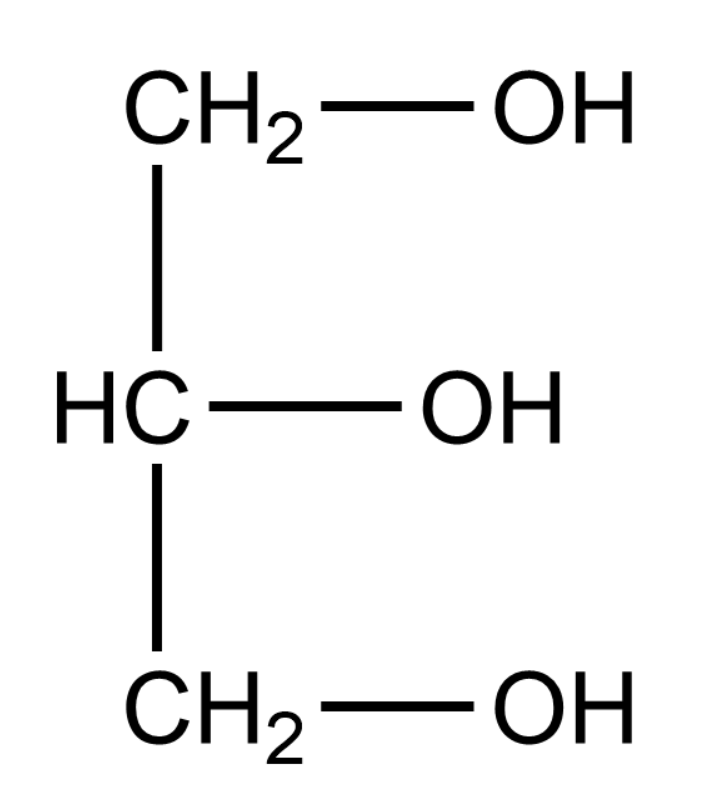
Trihydroxypropane is a component of
A.Amino Acid
B.Lipids
C.Nucleic Acids
D.Enzymes
Answer
489k+ views
Hint: Trihydroxypropane is commonly known as glycerol and it is an important component in Biological structures. It has a general formula of \[{C_3}{H_8}{O_3}\]. All of the given options are biomolecules. We can find out the correct answer by the method of elimination. The structure of glycerol is as given below:

Complete answer:
The production of the fat takes place in our body by the esterification reaction between the fatty acid and glycerol. Trihydroxypropane is a molecule consisting of three hydroxyl groups. Hydrogen is lost from each of the hydroxyl groups and hydroxide ion is lost from the 3 fatty acid molecules which take place in the presence of a dehydrating agent and thus forms fat. Three molecules of water are liberated in the formation of one molecule of fat and are removed by the dehydrating agent.
From the option given above, we can easily say that amino acids do not contain Trihydroxypropane nor do enzymes or nucleic acids. This means that the only option that we are left with is lipids. Lipids are interchangeably used as fats. Fats are a subgroup of lipids called triglycerides.
Therefore we can say that the correct answer for this question will be option (B).
Note:
Amino acids are the building blocks of proteins and contain an amino group and an acid group along with some organic groups. Enzymes are actually proteins that may or may not contain some metal ions or prosthetic groups. Nucleic acids are the basic building block of DNA and RNA. They are made of sugars, phosphate groups, and bases.

Complete answer:
The production of the fat takes place in our body by the esterification reaction between the fatty acid and glycerol. Trihydroxypropane is a molecule consisting of three hydroxyl groups. Hydrogen is lost from each of the hydroxyl groups and hydroxide ion is lost from the 3 fatty acid molecules which take place in the presence of a dehydrating agent and thus forms fat. Three molecules of water are liberated in the formation of one molecule of fat and are removed by the dehydrating agent.
From the option given above, we can easily say that amino acids do not contain Trihydroxypropane nor do enzymes or nucleic acids. This means that the only option that we are left with is lipids. Lipids are interchangeably used as fats. Fats are a subgroup of lipids called triglycerides.
Therefore we can say that the correct answer for this question will be option (B).
Note:
Amino acids are the building blocks of proteins and contain an amino group and an acid group along with some organic groups. Enzymes are actually proteins that may or may not contain some metal ions or prosthetic groups. Nucleic acids are the basic building block of DNA and RNA. They are made of sugars, phosphate groups, and bases.
Recently Updated Pages
Master Class 11 Accountancy: Engaging Questions & Answers for Success

Master Class 11 Science: Engaging Questions & Answers for Success

Master Class 11 Business Studies: Engaging Questions & Answers for Success

Master Class 11 English: Engaging Questions & Answers for Success

Master Class 11 Computer Science: Engaging Questions & Answers for Success

Master Class 9 General Knowledge: Engaging Questions & Answers for Success

Trending doubts
Which are the Top 10 Largest Countries of the World?

Draw a labelled sketch of the human eye class 12 physics CBSE

State the principle of an ac generator and explain class 12 physics CBSE

Differentiate between insitu conservation and exsitu class 12 biology CBSE

Sketch the electric field lines in case of an electric class 12 physics CBSE

Give 10 examples of unisexual and bisexual flowers




